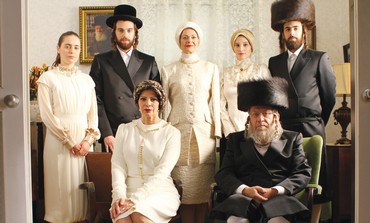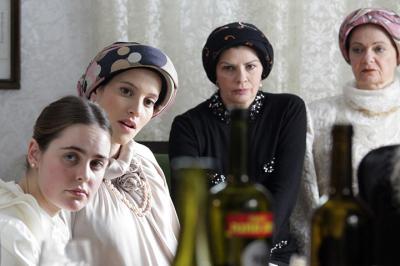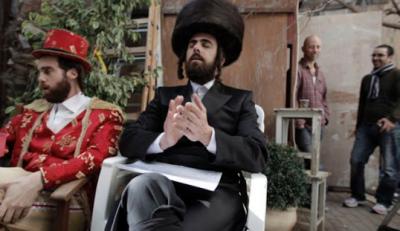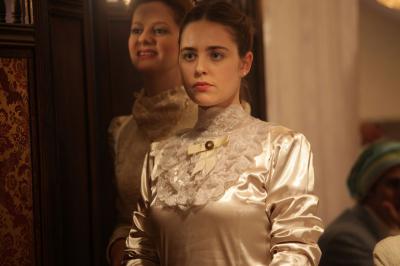By: debbie lynn elias
Writer/director Rama Burshtein takes us deep into the world of an Orthodox Hassidic family and community in Tel Aviv with FILL THE VOID. In Hebrew with English sub-titles, the film plays like a soap opera or Jewish telenovella in terms of engrossing entertainment (and inherent humor thanks to the cultural aspects of the film), completely investing one in the story and the characters, leaving you craving more.

18-year old peaches and cream Shira is in need of a husband. With marriages arranged by the families, we meet Shira and her mother Rivka at the local supermarket where they are doing more than shopping for groceries. They’re shopping for a husband. After all, Shira wants to make certain he’s at least good looking, while Rivka wants to make sure he’s “acceptable”, especially given her place in the community being married to the rabbi. Finding the potential husband in the dairy aisle more than acceptable, bids are placed, plans are made for the young couple’s betrothal. But tragedy strikes as Shira’s elder sister Esther dies while giving birth to her first child. Making the situation more heartbreaking is that the death and birth happen during Purim, putting a damper on those festivities as well.
Mourning Esther means putting her wedding on hold. It also presents another problem. Esther’s husband Yochai is now alone with a newborn and in need of a wife; a matter more pressing than Shira’s marriage. And there’s also new grandmother Rivka who wants her grandson close to her, something that may not happen is Yochai’s parents get their way and marry him off to a woman in Belgium. For Rivka, there’s only one answer. Shira must marry her dead sister’s husband, Yochai. With the community desiring and blessing the marriage (after much wrangling by Rivka), it all comes down to Shira. Will she or won’t she?

Newcomer Hadas Yaron shines as Shira. Fresh-faced and naive yet with a determined spirit, she makes Shira standout from underneath the less than flattering Hassidic clothing and mores. Drawn to the project by “the beautiful script and beautiful story” Yaron, although Jewish, was completely unfamiliar with the Hassidic culture. “We had the same holidays because we’re all Jewish in Israel. [But] we celebrate it and do it completely different. We just have a meal with our family and then we go on with our things and our lives and they [the Orthodox] have something much more meaningful. I didn’t know anything.” Making this film a fulfilling experience for her is that “There’s something very unique about the fact that nothing [the script] was “pushy”. It’s just so thorough. Even when you say something, it’s not necessarily what you would mean. . . It’s not only the words that say something in the film. It’s much more than that. I don’t think there are a lot of scripts like that.” Young at the time of filming and only her second film, Yaron recalls that “even during rehearsals I didn’t know how to act with someone in that the movie tells a love story. . . I remember there was also tension there because I was embarrassed a lot; also, the fact that we didn’t rehearse a lot. Every time we did the scene until we got it, then Rama [would say] to “leave it there” so the tension would remain.”

Irritating, meddling and spellbinding is Irit Sheleg who as Rivka exudes a diva-esque persona that while appropriately annoying with a “stick your nose in everybody’s business” air, just begs to be seen more. Her “Jewish mother” stereotype gives way to comic relief and never moreso than in the opening grocery store scene. Yiftach Klein delivers a flawed, vice-filled, human portrayal of Yochai that resonates with the average person, be they Jewish or Gentile. As the not-getting-any-younger-still-single Frieda, Hila Feldman is a delight. You feel Frieda’s suffering as with each community member that marries or hooks up, she gets the obligatory, “Maybe you’ll be next”, not to mention appreciating the humor of some of the lengths she and her mother will go to try and snag her a husband especially when it comes to Klein’s Yochai. Every daughter in the world will appreciate Frieda and Feldman’s performance.
Written and directed by Rama Burshtein, “it was very complicated” to create FILL THE VOID, to hone in on and “to make this relationship between men and women and that enigma.” Filled with richly textured characters, it was also important was that the story be filled with passion. “Passion is wanting something you don’t have. I love that power of wanting and restraining. I feel that this is representative of secrets, the secret of everything.” Thus, it required a delicate balancing act in designing the relationship between Yaron’s Shira and Yiftak Klein’s Yochai in order to maintain that restraint and that energy, that “almost kiss”. “If they would have like a love scene, it would die.”

Thanks to her clean, unfettered lensing allowing the characters, traditional (albeit unflattering) costuming and religious traditions to come to the forefront. Herself part of the Hassidic community, she has an intimate understanding of the culture and the people which she allows to organically flow with unforced naturalism, lending to a beautiful poetic lyricism. Spurring Burshtein forward was the fact that “My community – the overlooked people – they don’t have a cultured voice. You don’t even see it in books or anything with the arts. I thought that it’s time to have a little voice and to just say something from within.” Admitting that she “was not always religious” FILL THE VOID stems from a real life experience. “ One of the first things I saw before I joined in the clan, a good friend of mine was about to marry her son in the evening. And her mom died that morning. We went to the funeral with her. She buried her in the afternoon and then she married her son at night. It fascinated me how you can handle two opposites. I think this is the power of Judaism. That’s one law, to bury the mother. And there’s another law, to marry a son. . . This is life. No one’s a villain. No one’s bad. Everyone’s human and human means that they [are] all coming together.”
Important to Burshtein is the authenticity of emotion. “I get a lot of the people from the Orthodox community telling me how accurate this is. But then again, it’s a story of a certain family and is typical of anything. It’s life. . . Being Orthodox means being very individual, being very private and having your own private way of doing the spiritual work. It’s accurate with the way it looks and the way people talk but again, it’s very very personal.”
Notable is that the visuals present a very cloistered, very claustrophobic community, much of which is conveyed through camera movements, through the intimacy of one-shots or very close two-shots bordering on a one-shot. Achieving this emotional cloistering was a close knit partnership between Burshtein and her cinematographer, Asaf Sudri, who is described by Burshtein as a “brilliant, brilliant man”. Together they approached the story with a few things in mind. “One, I knew that the real location of the film is [Shira’s] heart and the journey is about trying to figure out what she feels. So, I went with the doors and the rooms and the house. Then the other thing was that we see fractures of a picture. It’s like Old Guards. . . so I went with that, too. That was very important. And then, this is a very low budget film and I knew what I had was a frame and a character. . .I have the script and I have a character and a frame. . .the lighting and the frame.” To Burshtein, “the heart, it’s very colorful, very small but then it’s on a widescreen.” With that in mind, she and Sudri worked on framing. “There is room, even though it’s very claustrophobic, you see air and on the sides. So it was very important that we shoot that on a widescreen.” Confident, simple framing concentrating on the intimacy of a one-shot or two-shot scene, fill the screen with realism, buttressed by the authentic production design and costuming allowing for the almost poetic emotion to come to the forefront.

Costuming is meticulously created to retain the cultural and religious mores of the Hassidic community. Calling on costume designer, Hani Gurevitch, “It was very important for me with how they dressed. A lot of the budget went on clothes.” Incorporating padded and quilted fabrications, heavy round beading, wide asymmetrical ruffling, turtlenecks, bustline floral corsages for the single women and then more Alexis Carrington “Dynasty” suited looks for the married women, goes far in telling the story and imparting information to the audience and outsiders. Similarly, men are garbed in traditional religious attire, adding depth to their characters.
Steeped in tradition, religion and ritual, FILL THE VOID fills a void in cinema with warmth and insight into the mysteries of love and life.
Written and Directed by Rama Burshtein
Cast: Hadas Yaron, Irit Sheleg, Yiftach Klein












